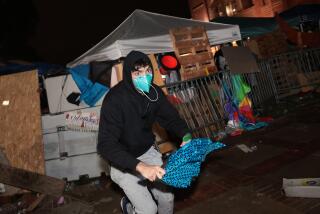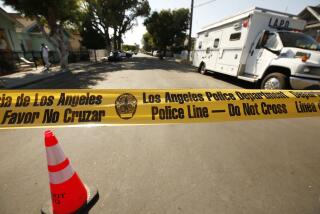Rebels, Bracing for Attack, Get an Air Force as Copter Crews Defect
- Share via
MANILA — The helicopters churned in at dawn Monday, low over the parade ground at Camp Crame, where rebel soldiers had waited through a tense night for a government attack that had not yet come.
Riflemen scrambled into firing position and trained their weapons on the field. But this was not the attack. The choppers set down and their crews jumped out, waving white flags.
“They were supposed to attack us. They landed instead,” said Brig. Gen. Eduardo Ermita, spokesman for the mushrooming mutiny led by former Defense Minister Juan Ponce Enrile and Lt. Gen. Fidel V. Ramos, just five days ago the acting armed forces chief of staff.
The defection of the 15th Strike Wing, led by Col. Antonio Sotelo, began a bright day for the defenders of Camp Crame (pronounced krah-may). Before it was over, Sotelo’s helicopters had rocketed the palace grounds of President Ferdinand E. Marcos and strafed government choppers at Villamor air base, their home field.
A few hours after the 15th Strike Wing gave the rebels an air force, Enrile and Ramos walked out of their headquarters building to hail their supporters, military and civilian. Ramos, dressed in blue fatigues, bounced on the stage like a cheerleader when Enrile introduced him. He praised the “loyal forces of the Armed Forces of the Philippines that kept faith . . . and defended this little bastion of Camp Crame.”
Joy or relief was infectious in the crowd. Soldiers embraced in the morning sun and were clapped on the back by throngs of civilians who had stood vigil outside the walls during the night, placing themselves between the rebels and any government assault.
Troops reached through a spiked fence to shake the outreached hands of supporters on the street.
Spirits were lifted in part on a false note--radio reports that Marcos and his family had fled the country in the face of the rebellion. Still, Enrile said, “It helped us. It galvanized the people.”
Twenty-four hours earlier, the atmosphere at Crame had been defensive, waiting for the blow to fall. Enrile said he was prepared to die there, and it seemed probable.
On Monday, still wearing a flak jacket and carrying a submachine gun, Enrile, once the unpopular administrator of martial law under Marcos, was a hero to his supporters.
“I can’t tell you how proud we are of Johnny Ponce Enrile,” his sister said.
He gave credit to the continuing stream of defectors for the change in mood at the camp on the outskirts of Manila. “The air force came over to us,” Enrile said.
In the five-story headquarters building, rooms and hallways were bristling with arms. American-made M-16 assault rifles were carried by clerks and commandos. So were the sawed-off versions. Rifle butts banged together as soldiers passed in the crowded halls.
Troops stripping off shirts stinking from a night of restless sleep or guard duty bared revolvers in their waistbands.
A reporter going for an outside telephone line on a secretary’s desk had to hurdle an M-60 machine gun draped with bandoliers.
The uniforms were as varied as the guns. Most officers wore the works--camouflage fatigues, magazine belts, boots. One enlisted man had a Philippine Airlines T-shirt, fatigue pants and dress shoes. A clerk wore a cleanly pressed uniform and tennis shoes.
Most wore a small Philippine flag as a shoulder patch. Many had attached yellow ribbons--the symbol of opposition leader Corazon Aquino--to their clothing or weapons. The mean, cold steel of one M-16 had a yellow bow tied around the barrel.
Soldiers and reporters gathered around radio and television sets following developments of the rebellion. When Marcos told a TV audience that “we are treating them (the men at Crame) as rebels,” three young troopers laughed nervously and pointed at each other.
Danger seemed close, and it was in fact just across the street at Camp Aguinaldo. There, marines and soldiers loyal to Marcos had the capability to shell Crame at any time.
When the crowds pressed onto the parade ground to watch the return of Sotelo’s helicopters from the raid on Villamor, heads and fingers suddenly snapped upwards. A fighter plane was slowly circling the base at high altitude. Expecting retaliation for the raid, people starting backing away from the helicopters, the likely targets.
“It’s OK. It’s one of ours,” said an officer. By day’s end, the rebels claimed that nearly every combat plane in the Philippines was on their side.
But the threat of loyalist artillery, armor and ground troops remained. At 6 p.m., a loudspeaker truck moved through the camp telling civilians to move outside the walls and reporters to display their credentials. “We have reports that we have already been infiltrated,” the voice said.
It was possible, too, that the rebels wanted the civilians to jam the streets again, creating a sacrificial buffer between the soldiers and any attacking force. What Ramos called “people power,” a human blockade, has proved the rebels’ strongest weapon, stopping a certain armored attack on Crame on Sunday.
As the sun set on the camp Monday, its buildings and office walls emblazoned with legends in praise of Marcos, the troops settled in for another uneasy night.
More to Read
Sign up for Essential California
The most important California stories and recommendations in your inbox every morning.
You may occasionally receive promotional content from the Los Angeles Times.













